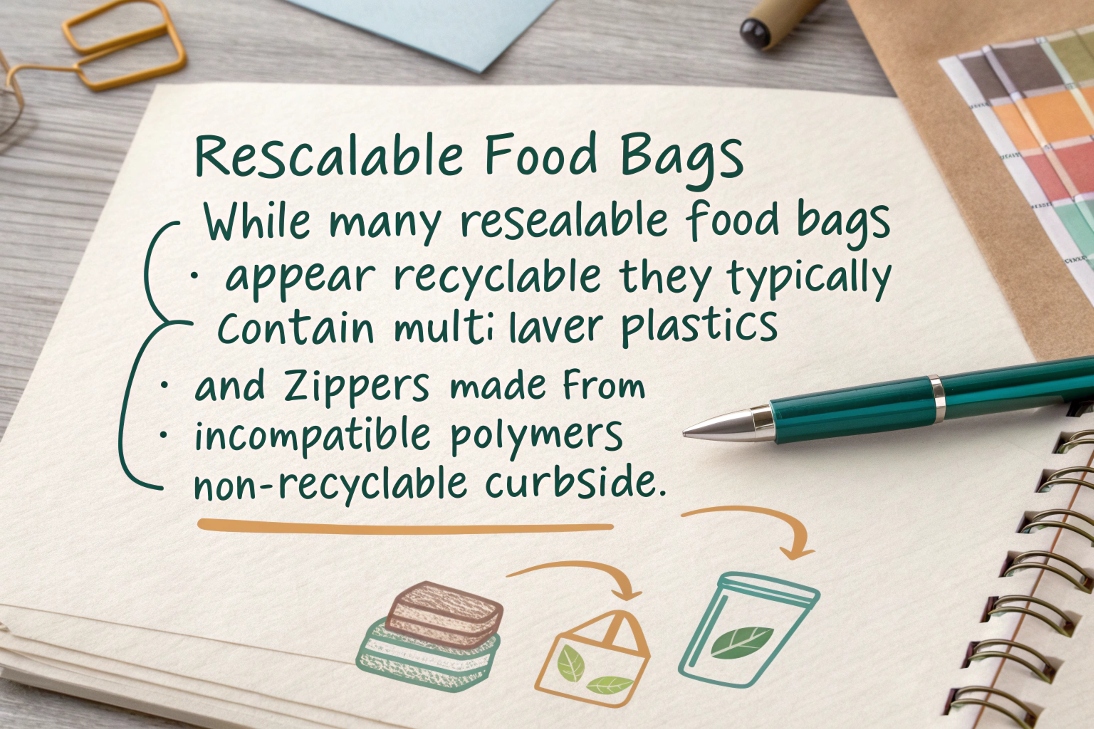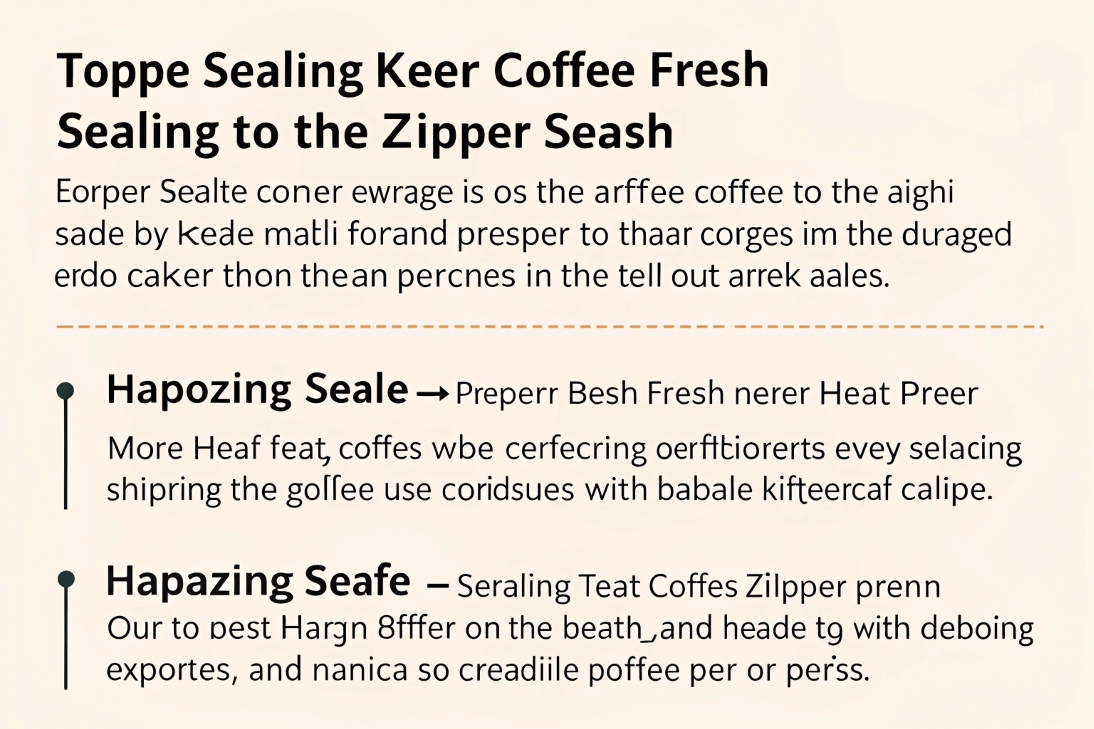You’ve probably flipped over a coffee bag, looking for the recycle symbol—only to find none.
Resealable zippers in coffee bags are often not recyclable due to mixed materials and complex lamination.
One of my customers from Canada once asked me, “We’re trying to go green—can we still use zipper pouches?” That led to a longer conversation about what’s really recyclable and what’s just “wishcycling.”
Are resealable food bags recyclable?
Many resealable food bags look recyclable—but are they?
Most resealable food bags are not recyclable curbside1 because they use multi-layer plastic2 and zippers made from incompatible polymers.

Why multilayer materials complicate recycling
Resealable bags are made with performance in mind: to protect freshness, moisture, and aroma. That means:
- Outer layer: for printing and strength (PET, BOPP)
- Middle layer: for oxygen/light barrier (VMPET, AL)
- Inner layer: for sealing (PE, CPP)
- Zipper: usually LDPE or PP
These layers are laminated together. While each material may be recyclable alone, once bonded, they can’t be separated by most recycling facilities.
| Component | Material | Recyclable? |
|---|---|---|
| Outer film | PET/BOPP | Sometimes, if clean |
| Barrier | VMPET/AL | No |
| Zipper | LDPE | Only in special programs |
| Whole bag | Multi-material | Not curbside recyclable |
Dive deeper: store drop-off programs
Some supermarkets accept soft plastics3 (like LDPE). But zippers must be removed. That limits real-world recyclability.
Brands that claim “recyclable pouches” usually mean mono-material pouches4 with no aluminum and with zippers made from compatible materials.
Are coffee bags recyclable?
Coffee bags are built for preservation—but not for recycling.
Traditional coffee bags are not recyclable due to aluminum layers, plastic blends, and degassing valves5.
Common coffee bag structures
| Type | Structure | Recyclable? |
|---|---|---|
| PET/AL/PE | Foil barrier with lamination | ❌ |
| Kraft/VMPET/PE | Paper look, metal inside | ❌ |
| Mono PE/PE | All-polyethylene | ✅ (limited) |
| Compostable PLA | Plant-based film | ♻️ Industrial only |
Degassing valves—often made of polypropylene—further complicate things.
Dive deeper: compostable ≠ recyclable
Some newer coffee bags use PLA (corn-based plastic). These bags are not recyclable, but compostable in industrial settings only, not at home.
In our own IMIPAK factory, we’ve helped clients transition to mono-material PE coffee bags with PE zippers. These bags can be recycled in countries with soft plastic collection programs, but not everywhere.
Are zip seal bags recyclable?
From home use to industrial packaging, zip seal bags are everywhere. But can they go in your recycling bin?
Zip seal bags made of a single material like LDPE are recyclable through store drop-off programs—but not curbside.
Home-use zipper bags vs industrial zippers
- Home-use (e.g. Ziploc®): Usually 100% LDPE
- Coffee bag zippers: Often mixed with PE, PP, or adhesive
To be recyclable, the bag and the zipper must be from the same polymer. Also, it must be clean and dry.
Dive deeper: what about in coffee packaging?
Resealable zippers on coffee bags are heat-sealed into place. That means glue, pressure, and multiple polymers. Even when the pouch is mono-material, the zipper might not be.
At IMIPAK, we offer recyclable zippers6 made from the same base film (PE or PP) to ensure compatibility. But this must be clearly communicated to both customers and recycling facilities.
How to seal zipper coffee bags?
Zippers keep coffee fresh—but how do you seal them for sale or shipping?
Zipper coffee bags are sealed above the zipper using a heat seal7er, while the zipper itself is reclosable by the customer.

Sealing methods for coffee pouches
| Sealing Area | Method | Notes |
|---|---|---|
| Above the zipper | Heat seal | Creates tamper-evident closure |
| Zipper line | Manual press | Allows resealing after opening |
Dive deeper: why sealing matters
For export clients like those in Europe or North America, a heat seal7 is mandatory to prevent tampering. Many buyers also request tear notches8 above the zipper to make opening easier.
Some clients ask: “Can I skip the top seal and just use the zipper?” We always advise against it. Without a seal, the coffee loses aroma faster, and shelf life shortens significantly.
At our factory, we offer tear notch + zipper + top seal as standard on all coffee pouches.
Conclusion
Resealable zippers are great for freshness, but they rarely make coffee bags recyclable.
-
Learn what can be recycled curbside to improve your recycling habits and reduce waste. ↩
-
Discover the challenges of recycling multi-layer plastics and how they impact the environment. ↩
-
Find out how to properly recycle soft plastics and contribute to a greener planet. ↩
-
Explore the benefits of mono-material pouches for sustainable packaging and recycling. ↩
-
Learn about degassing valves and their role in coffee packaging and freshness. ↩
-
Find out about innovative recyclable zippers that can improve sustainability in packaging. ↩
-
Discover the significance of heat seals in maintaining product freshness and safety. ↩ ↩
-
Learn how tear notches enhance user experience and convenience in packaging. ↩


